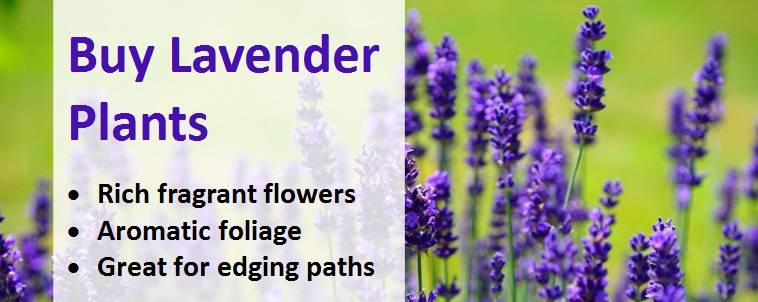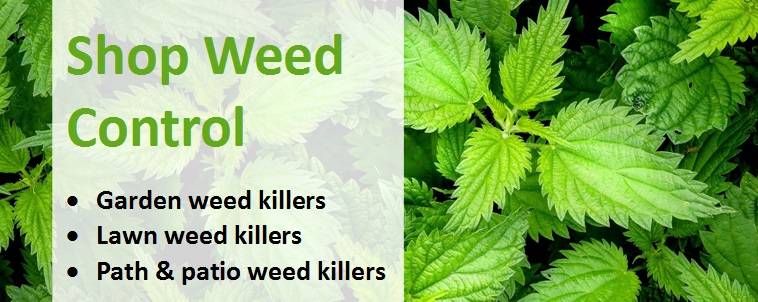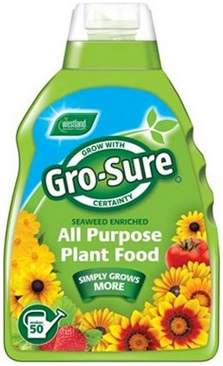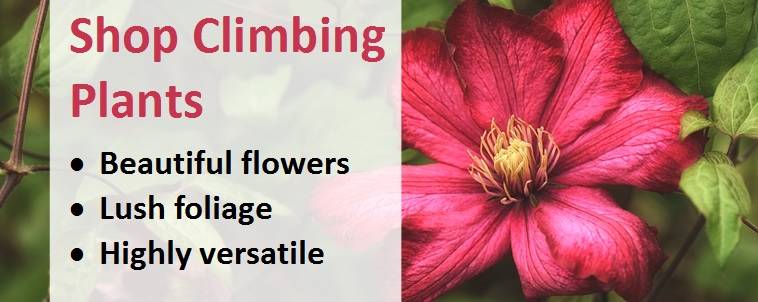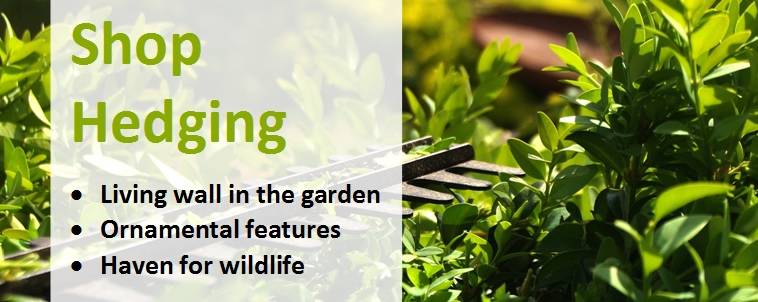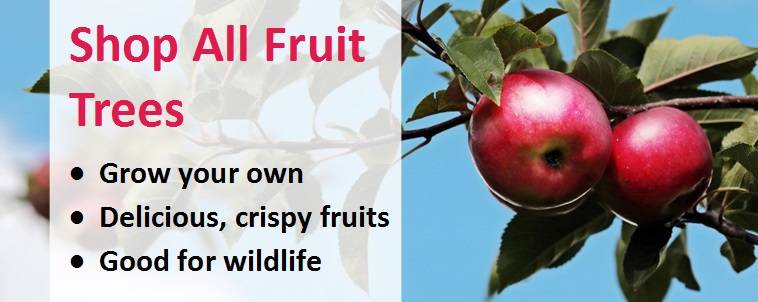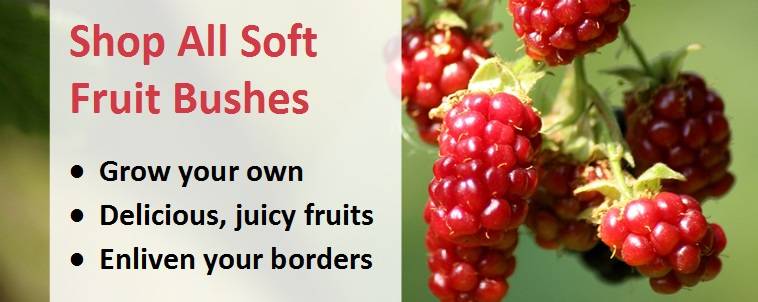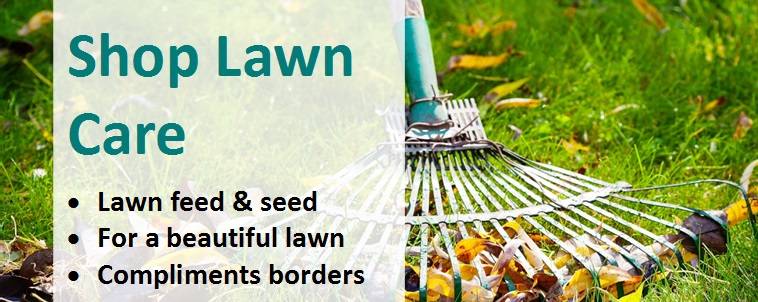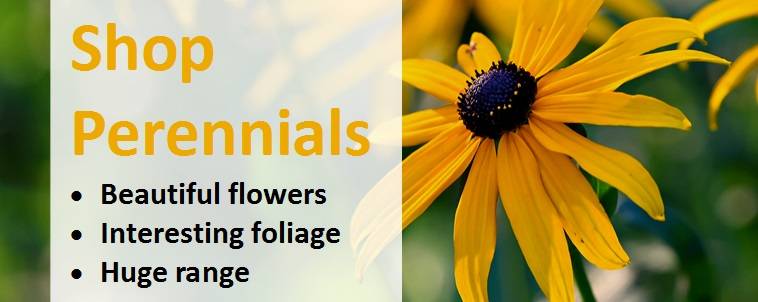Check Here Before Buying – Pot Size Matters...Not all websites offer the same. Plants in a 2-litre pot have twice the root system of a P9 or 1 litre pot.
August Gardening Jobs
As the traditional month for summer holidays, you may need to enlist the help of family and friends to tender to your garden if you're going away in August. Many parts of the fruit and vegetable garden will be ready for you to harvest the fruits of your labour this month. In the flower garden top-heavy bulbs and late flowering perennials need staking and shrubs, perennials and climbing roses that have finished flowering can be cut back. Evergreen hedges looking shaggy after their burst of summer growth should be trimmed back and topiary sculpted to shape. As well as the on-going dead heading, weeding and mulching, it's also the time to tie in raspberries and replace any straggly lavender bushes. Keep an eye out for pests and diseases like clematis wilt, mildew, ear wigs, ants, scarlet lily beetles and vine weevils, whilst also fending birds off your fruit. Don't forget to take some time out to enjoy your garden and just spend some time being in it too.
Across the Garden
Watering
- Keep your plants well watered through the summer heat, paying particular attention to newly planted shrubs & perennials and plants in containers which are most vulnerable to drying out. Check for moisture daily by pushing your finger into the top of the soil. Keeping Camellias and Rhododendrons well watered will ensure they develop strong buds for next year's display.
- Use grey water where possible, especially if your water butt is running low after a hot summer.
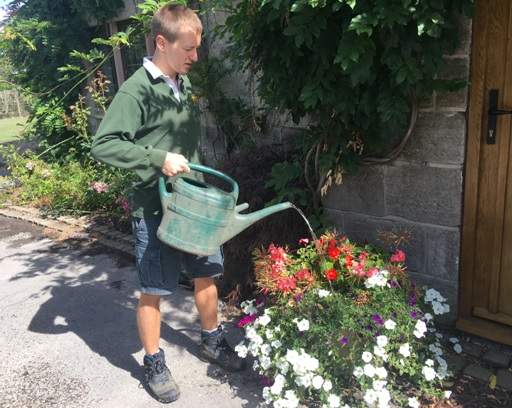
- Apply a generous mulch of well-rotted garden compost, leaf mould or manure to help lock in moisture for longer. Spread the mulch after a good downpour or thorough watering.
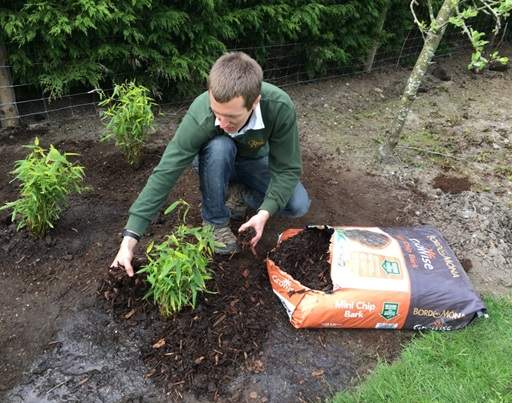
Weeding
- Weeds will be growing more slowly than in the spring, but it's still worth hoeing the soil to keep them at bay. Do this on a hot, dry day and the weeds left on the surface will dehydrate and die.
- Spray perennial weeds such as ground elder with a glyphosate-based weed killer like Roundup. It is most effective in summer as the weeds have a large leaf surface area to absorb it.
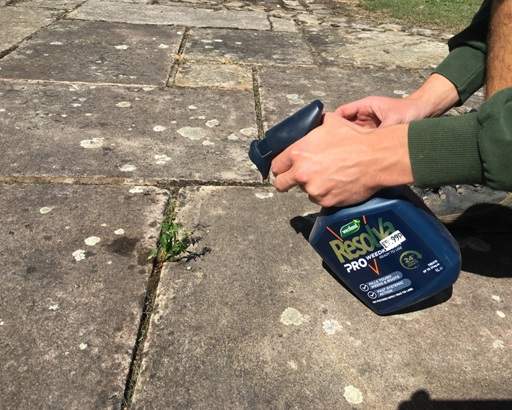
- Boiling water also makes an effective weed killer on paved areas, causing them to wilt and die.
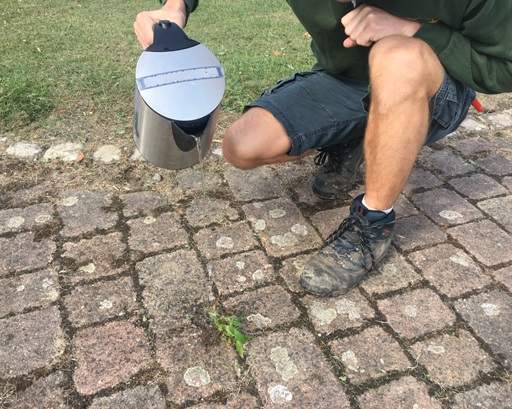
Feeding
- Feed containerised plants with a liquid fertiliser once a fortnight. There are three ingredients - nitrogen, potassium and phosphorus. Nitrogen helps plants develop strong stems and foliage; potassium supports growth of flowers and fruit; and phosphorus develops the root system.
- Fruit and vegetables, as well as flowering perennials, climbers and shrubs, will want a high potassium feed, often sold as "tomato food". Most other plants you'll want to feed at this time of year will favour a multi-purpose feed. In most cases it's a bit late for a high nitrogen feed as the leafy growth it encourages will be vulnerable in the colder weather in a couple of months' time.
|
|
|
In the Flower Garden
Dead Heading
- Dead head perennials and bedding plants regularly to encourage a continuous flush of new blooms and prevent them from self-seeding, cutting back to just above a leaf where possible.
- Lilies have now finished their best display - remove their flowers for best results next year.
- Shear back chrysanths to encourage more growth and flowers.
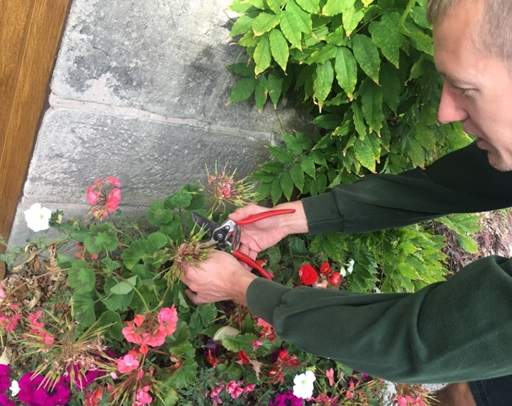
Pruning
- Keep borders looking tidy by removing faded flowers & spent foliage on perennials and bedding.
- Cut back summer flowering shrubs such as Hebe and Cistus once their flowers have finished.
- Cut back rambling and climbing roses once flowering has finished, being careful to check whether they are repeat flowering varieties first - if they are, leave them to re-bloom.
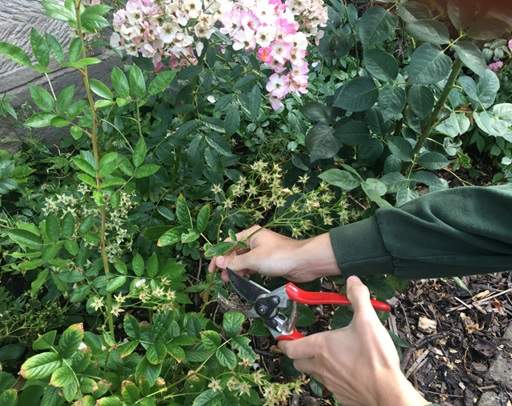
- Rambling roses flower on last year's wood so you'll need to prune in two stages. Firstly, cut out older wood to the ground to encourage new growth and cut sideshoots that have flowered back to 2-3 buds from the main stem. Secondly, tie in new wood ready for flowering next year.
- Most long-flowering perennials such as Geraniums will have finished flowering now. Cut them right back to the ground, water and feed to encourage a second flush of blooms in the autumn.
- Cut back herbs to encourage them to develop a fresh set of tasty leaves before the first frost.
- Trim lavender once flowering has finished to keep growth compact and avoid leggy stems. Use the final faded flower heads as potpourri in the bathroom to bring the scent into your home.
- If your lavender has become twiggy and misshaped your best bet might be to take cuttings or buy in some new lavender plants. Lavender rarely grows from old wood so once it's gone straggly it's unlikely to recover its form.
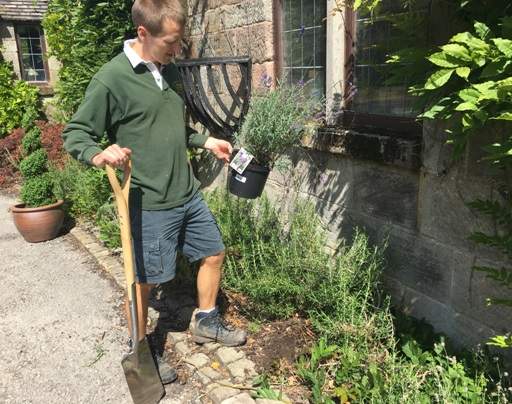
- If you didn't do it in July, prune the whippy growth of ornamental vines, Wisteria and Honeysuckle to within 5-6 buds of the main stem to prevent it getting out of hand. This will encourage buds to form and give you a beautiful display of flowers next year. If you have a young specimen which you're looking to train further up the wall or support, do not cut its whippy growth and instead tie it into your support to extend the framework of branches.
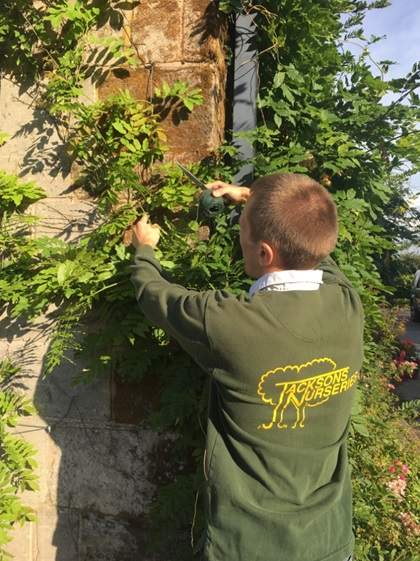
- Remove side buds from Dahlias if you want to develop a larger single flower for cutting.
- Large flowered clematis should now be blooming in fully glory. Continue to watch out for clematis wilt. Tell-tale signs are wilting and discoloured stems and leaves. Remove the affected parts and dispose with your household waste.
Staking and Support
- Stake top-heavy bulbs such as Lilies, Dahlias, Asters and Helianthus to stop them blowing over or toppling in the rain. A good technique is to enclose them in a square of thick canes planted firmly into the ground, secure at the top and wrap the stems around them using garden twine.
- Also stake late-flowering perennials like Rudbeckia, Echinacea and Asters. They'll have much more impact looking upright and perky than toppling sideways.
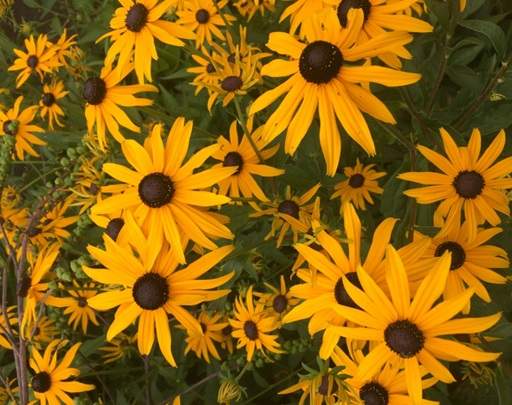
Lift & Divide
- Old clumps of Bearded Iris, Polyanthus and Pulmonaria can die back at the centre after a few years and become reluctant to flower.
- Rejuvenate them by lifting with a garden fork and prising the roots into 3-5 smaller sections with a spade or knife, replanting 15cm apart.
- Replanting now will give them enough time to form roots and flower buds for next year in their new location before the weather gets too cold.
Sowing and taking Cuttings
- Line up a splash of colour for September and October when borders can be looking sparse by planting colchicum bulbs (known as autumn crocus) in the border at 10cm deep in a sunny spot.
- If you're planting new clematis, plant them deeply at 10cm below the level they were in the pot to reduce the risk of clematis wilt.
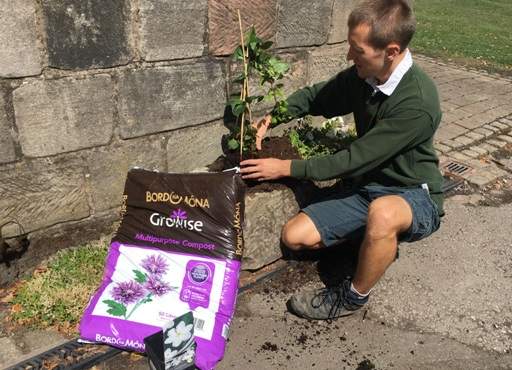
- Start sowing hardy annuals by the end of the month ready for next year.
- August is probably your last chance to plant perennials like foxglove, masterwort and yarrow so the roots have enough time to establish before the autumn.
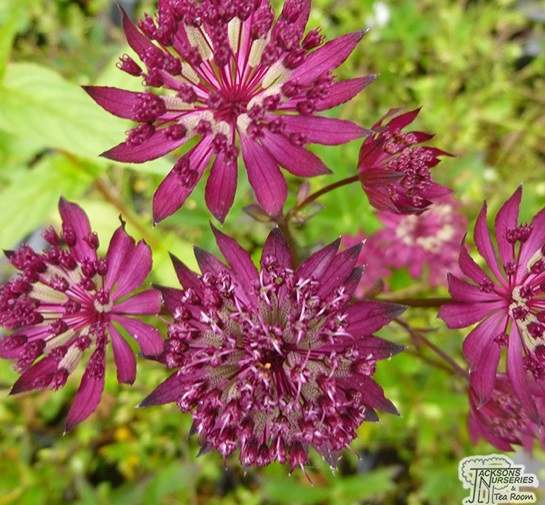
- Take cuttings of tender perennials such as fuchsia and pelargoniums ready for next year. They're growing at full tilt now so will root very quickly. Take cuttings from healthy plants and give the parent plant a thorough water a few hours before taking the cutting.
- Collect ripened seeds from plants you want to grow next year. Store in a cool, dry place in envelopes labelled with the plant name and harvest date. Leave some seeds on your plants if you want them to self-seed into the surrounding soil.
Pest Control
- Powdery mildew can disfigure the leaves of perennials such as michaelmas daisies. Mildew appears as white blotches on leaves, looking a bit like talcum powder. If spotted, treat with a fungicide spray, keep checking your plants and repeat every 2 weeks as required.
- Catch earwigs on your dahlias by positioning an upturned pot filled with straw or shredded newspaper on top of a set of canes amongst your plants. Earwigs will crawl into the pots which can then be emptied in the morning.
- Watch out for ants establishing colonies in the base of planted containers. If spotted, use an ant killer to stop them undermining roots and drying out your plants from the base. An alternative is to stand your plants above the water level in a large saucer of water.
- Remove and crush any scarlet lily beetles you spot on your lilies, checking and removing any sticky brown larvae on the underside of leaves in the process.
- If there is no obvious cause for your plants looking ill, check for vine weevils ('C' shaped creamy maggots) in the root system and treat with nematodes as required.
Trimming Hedges
- Evergreen hedges such as laurel, box and privet will have put on lots of growth over the summer making their outline a bit shaggy. By the end of this month birds should have left their breeding nests so you can start to prune.
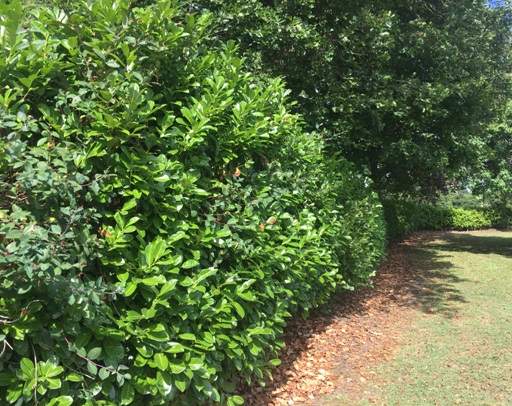
- Give them a clip using hand shears or a powered trimmer to keep them looking smart before they stop growing in the autumn. If your hedge is large-leaved it may look better aesthetically to use secateurs so you can trim off whole leaves rather than cut through half a leaf.
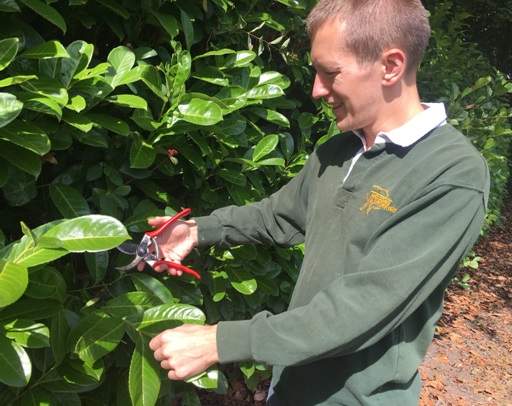
- Start with the sides of your hedge, beginning at the bottom so you can see more clearly how much you've taken off as cuttings fall to the ground rather than getting caught on foliage below.
- The aim is to "batter" the hedge, meaning to leave it wider at the base than at the top. This way it'll be better equipped to withstand the winter weather.
- Cutting to a line is the best way to get a straight top. Knock in a couple of posts at either end of the hedge and tie some twine between them at the height you want to achieve, making sure the twine is horizontal (or parallel to the ground if you're on a slope) before you start cutting.
- Conifer hedges are the exception. They will continue to grow until October so should be clipped back later in the year.
Clipping box and yew balls
- Clip evergreen box and yew balls. Do this on a dry day to reduce spore spread and ensure there is good air circulation around your plants to reduce the risk of box blight.
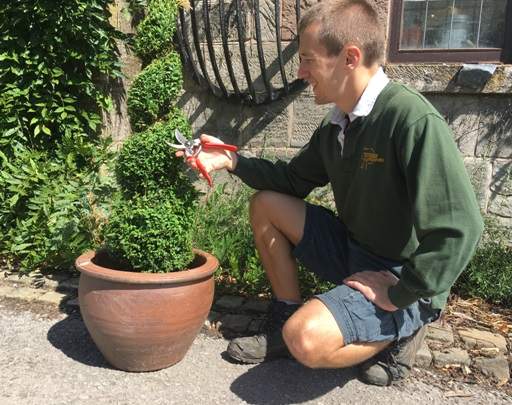
- With box blight becoming an increasing menace we recommend trimming box balls and hedges a bit looser and removing some internal braches to allow air to circulate through and around the plant to prevent the fungus spores of the blight from settling.
- Other ways to prevent box blight are to leave 50cm clear around your plants, applying a preventative systemic fungicide and pruning in winter instead when the disease is dormant.
Vegetable Garden
Harvesting
- Large parts of the fruit and vegetable garden will be ready to harvest this month.
- Carrots, beetroot and early potatoes sown in spring should be ready to harvest. Take them little and often as needed, leaving some in the ground to keep growing.
- Main crop potatoes are ready to harvest when the leaves turn yellow and die back. Store your potatoes in a cool, dry place with good ventilation - hessian sacks are perfect.
- Harvest sweet corn when you can pop a corn with your thumbnail and the juices are milky. If no liquid comes out when you squeeze with your thumb you're too late!
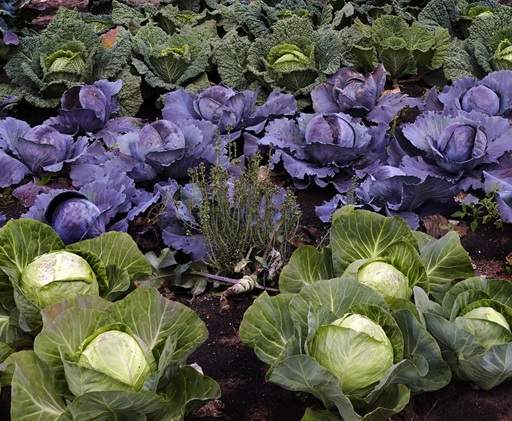
- Pick french & runner beans little and often for a regular supply and to stop them setting seed. If mature pods set seed you won't get further flowers, reducing your crop.
- Harvest onions, shallots and garlic when the foliage turns yellow and starts bending over. Hang garlic in a sunny, dry place to ripen. Store onions in onion bags or wooden fruit boxes.
- Keep picking courgettes when they're about 10cm long. This will encourage more to grow and prevent them turning into tough, woody marrows.
- Harvest, dry out or freeze enough herbs to give you a good supply for the rest of the year.
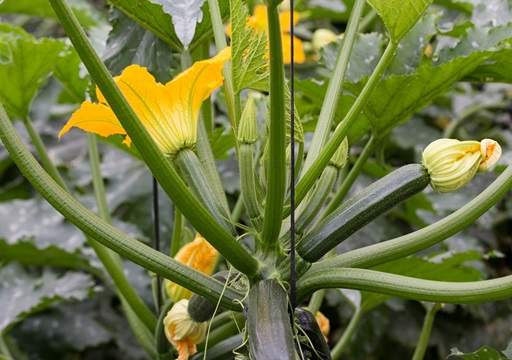
Sowing and Growing
- Thin out parsley plants to 25cm so they can establish a good root system before the winter cold. If you're yet to sow parsley, fill a shallow tray with compost and sow thinly over the surface, covering with 1cm of compost. Water and put in the cold frame. Seedlings should appear in September and you'll be able to pick it all winter.
- Transplant leeks to their final positions once they are the thickness of a pencil.
- Sow spinach in 2.5cm deep rows (thinning to 7.5cm once germinated) for a late September crop.
- Sow small pots of marjoram, basil, coriander, dill, chives and other herbs. These can be put outdoors for the time being then moved indoors in late autumn before the first frost.
- If you have congested clumps of chives already growing in the border these can be lifted and divided this month too.
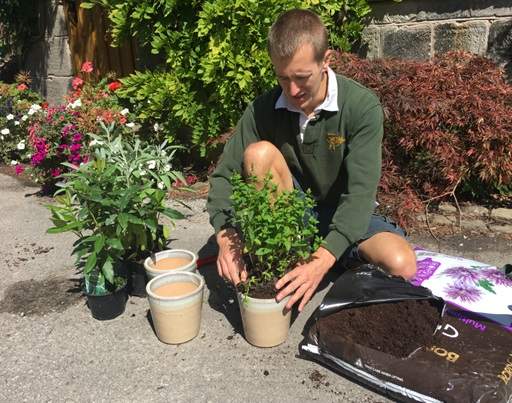
- Plant seed potatoes in a frost-free greenhouse or in containers which can be moved indoors. once it gets cold. They should crop within 12 weeks of planting.
- Do a last sowing of beetroot - if you mix patches or stripes of different colours - purple, pink and white and orange - they'll look fabulous on top of a rocket and feta salad.
- It's also your last chance to sow spinach, chard, lettuce and other salad leaves.
- If your veg patch is chock-a-block, sow in a gutter pipe inside to transplant outside in about a month’s time when there should be more room.
- Take cuttings of mint, rosemary and sage herbs to bolster your supplies. Pull a side shoot from a main stem with a small heel of bark attached in the case of rosemary. Remove some of the bottom leaves and pinch out the growing tip.
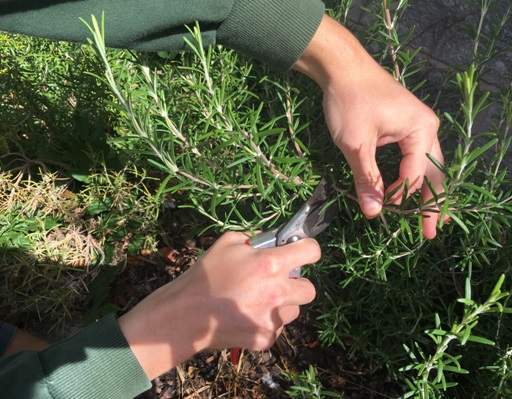
- Cuttings grow readily in an equal mix of grit and compost in a cold frame. Giving them a trim will encourage a new flush of leaves that can be harvested later in the year before the first frost.
- Consider sowing green manures to mop up nutrients, preventing them being washed away by rain. These will be dug in next spring to release valuable nutrients and improve soil structure.
Watering & Feeding
- Give the vegetable patch and fruit bushes a daily dose of water in hot weather.
- Feed tomato and sweet corn plants, peppers, cucumbers and aubergines with a high potassium fertiliser once a fortnight to get the best results.
Pinching Out and Cutting Back
- Encourage fruiting side shoots on runner beans at manageable heights for picking by pinching out the growing tips once they reach the top of their support.
- Pinch out leaders from cucumber plants grown in the greenhouse when they reach the top of the structure and shorten side-shoots to two leaves past each developing fruit.
- Remove any leaves below the lowest fruit trusses on tomato plants to allow good air circulation. Aim for 5-6 trusses per plant, pinching out growing tips so energy is focused on the tomatoes.
- For squash plants, limit the number of fruits to 3-4, making sure these are established and swelling well before pinching out the remainder. Remove any large leaves shading the fruits to help them ripen more quickly in the sun.
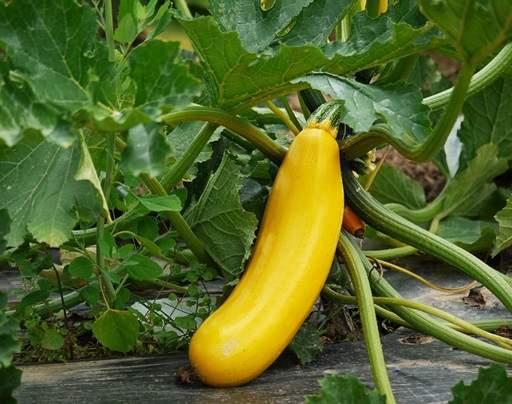
- Cut back bronze and green-leaved fennel. It will become a bit of a garden invader taking over parts of your garden where it's not wanted if it's allowed to set seed.
- Pinch out the growing tips of aubergines once they have 5 or 6 fruits.
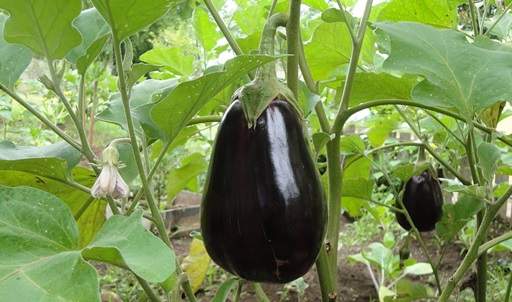
Avoiding Pests and Diseases
- Keep your veg patch clear of spent and damaged foliage to reduce the risk of pests and diseases.
- Look out for tomato and potato blight. Most common in wet weather, this is a fungus-like disease of foliage, fruit and tubers that causes rotting. If spotted, remove, destroy and dispose of the affected areas in household waste.
- Our top tips to avoid blight are (1) make sure there is good air circulation between your plants; (2) leave enough space between tubers; (3) use crop rotation to prevent disease from building up in your soil; and (4) apply preventative treatments of fungicide before blight appears.
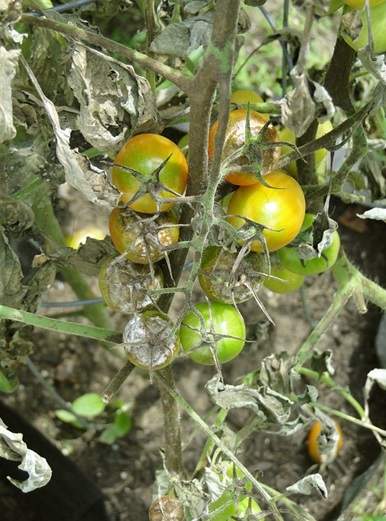
- Look out for cabbage white butterfly eggs under the leaves of cabbage and mustard plants. Squash any you see and consider using nematodes to kill the caterpillars.
- Watch for blossom end rot, a hard patch on the bottom of tomatoes which grows in size as the fruit swell, gradually becoming sunken and flat. Caused by a lack of calcium (found in water), it can't be reversed but at least you'll know you need to water your plants more often next year.
- Fend off slugs and snails using organic methods such as crushed egg shells or a slug killer. For vegetables grown in containers, copper slug tape around the pot can be highly effective.

Use a slug killer if organic methods don't work
Fruit Garden
Harvesting
- Plums, cherries, nectarines, peaches and apricots should all be ripe and ready to pick. Give them a gentle twist and if they come free with the stalk they're ready to eat.
- Check early apple varieties like 'Discovery' apple trees and 'Katy' apple trees - you may be able to start harvesting top fruit at the end of August. If the fruit comes free with the stalk in tact when lifted gently in your hand it is ripe and ready to eat.
- Early fruiting apples tend not to store well so eat up your harvest quickly. Any damaged fruits can go to animals or straight on the compost heap.
- Pick your final lots of raspberries, blackberries and loganberries. If you have a glut freeze them on trays for a couple of hours then bag them up in the freezer to use over the winter.
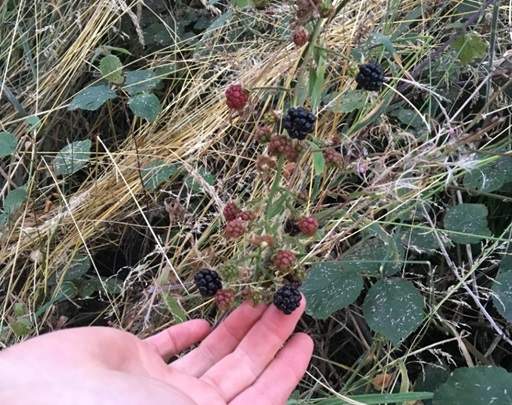
- Alternatively, use them to make pickles, jams and jellies that can be enjoyed for several months.
- Pick aubergine fruits when they are young and shiny.
Feeding
- Feed fruit trees in containers with tomato feed once a fortnight to encourage the best fruits.
- Feed citrus fruits such as lemon trees with a citrus fertiliser every 6 weeks through the summer.
- Fruit trees grown close to a wall inevitably suffer dehydration so keep their roots well watered.
Training & Pruning
- Prune the fruited stems of blackcurrant and raspberry bushes once the harvest has finished.
- Summer fruiting raspberries produce flowers and fruit on year-old canes, so leave the new green canes ready for next year's crop, tying them into support wires or fencing with garden twine.
- A good trick to help distinguish new and old canes is to tie them to different sides of your support. Don't bother tying in weaker canes as they won't fruit well.
- If any of the new canes have growth taller than the support structure leave the top in place for now and prune it back in winter when the plant is dormant.
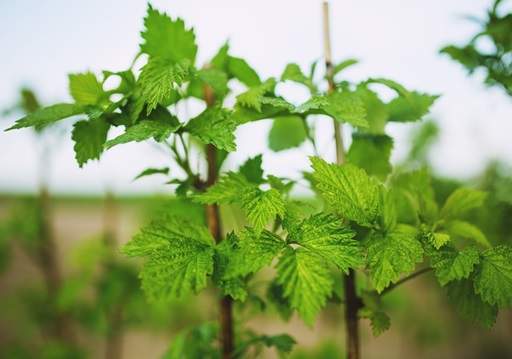
- Give fruit trees trained as cordons, fans or espaliers a summer prune after they have fruited. Cut back any growth on side branches from this year that is more than 20cm long to one leaf and reduce any shoots growing directly from the main branch to three leaves.
- Support plum trees by tying them into stakes, particularly heavy-cropping varieties such as Plum Victoria where the weight of the fruit can sometimes snap the branches without extra help.
- Prop up branches of other fruit trees that have borne a heavy crop so they can regain their strength.
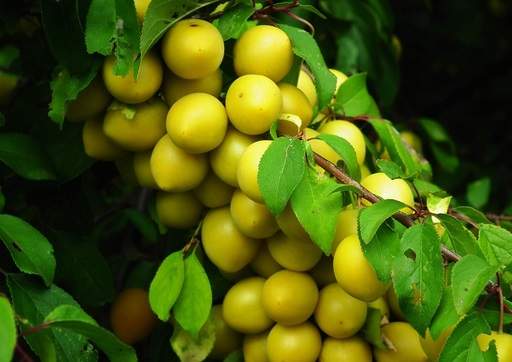
Protecting your Fruit
- If you haven't already, net your fruit trees and bushes that are not grown in a fruit cage. If you have large trees such as cherries outside of a fruit cage where it's not feasible to net the whole tree, consider protecting one branch or section and let the birds take the rest.
- Try some of these techniques to keep birds off your cherished crops:
1) Apply bird repellent scare tape, usually available in a silver diamond pattern, which uses reflected light and sound to provide an effective repellent for birds.
2) Create a "bird scarer" made from CDs tied to strings - the DIY equivalent!
3) Install scary balloons - these work by mimicking the glaring eyes and gaping mouth of predator birds, by their bobbing and weaving motion and waving tail ribbons.
4) Use a barrier such as netting, inverted crates, disposable cups (with their bottoms cut out) for smaller seedlings or chicken wire raised on boards or bricks. Make sure the netting stands well clear of the fruit.
Propagating new Plants
- Lift and pot up strawberry runners (baby strawberry plants) that you've rooted in the ground. Severe the stem between the runner and mother plant, then prise it carefully from the soil with a hand fork. Remove any dead leaves and pot into a small container with regular compost. Potted up strawberries can be forced for early fruit next summer.
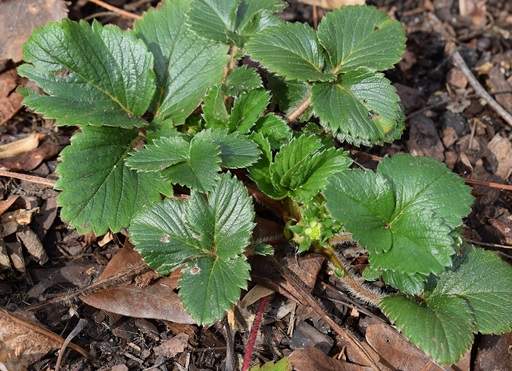
- Alternatively you could plant your new strawberries out in the garden so they can establish before the winter, using some of your runners as new plants. Always plant strawberries on ground where strawberries have not been grown recently.
Avoiding Pests and Diseases
- Remove old straw from around strawberry plants and tidy them up to improve ventilation.
- Check apples and plums for signs of brown rot fungal disease. Remove any fruit that has rings of white spores or soft brown patches on the outer skin and dispose with your household waste.
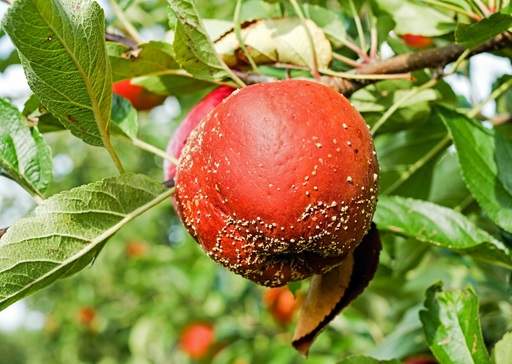
Lawn Care
- Turn on the sprinklers for 30 minutes once a week to keep your lawn looking lush and green. Don't worry if you forget to water and your grass turns brown, it will green up when it rains.
- A fine spray attachment on the hose does just as good a job if you don't have a sprinkler. Spike the lawn with a garden fork before watering if you ground is particularly dry and hard.
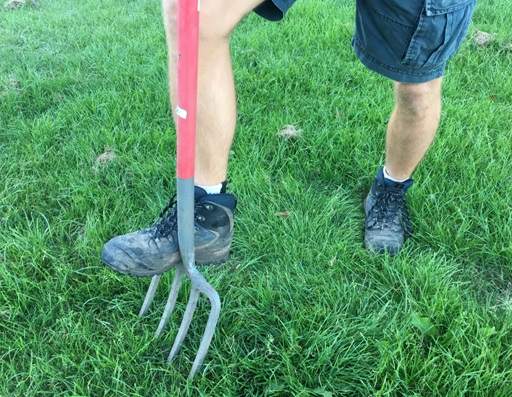
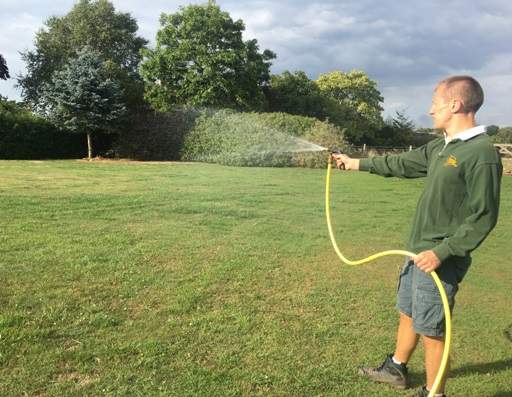
- The time for feeding your lawn has now passed. It's best to avoid feeding now as this will just create lots of new growth that's easily damaged by the autumn weather.
- As the growth of your lawn slows in late summer reduce cutting frequency to once every 10-14 days and raise the cutting height to help the grass cope with the heat.
- Follow the one third rule: don't cut more than one third of the height of your lawn in one go. Keep grass longer in shady areas and places which take a lot of wear and tear.
- If you have an ant infestation in your lawn, brush out the nests on a dry day before mowing.
- Watch out for crane flies (daddy longlegs) hopping across the lawn. Their larvae, known as leatherjackets, nibble the roots of your lawn causing unsightly brown patches. Treat with a leather jacket killer or nematodes as required.
- Re-cut lawn edges. Consider installing lawn edging to make maintenance easier.
- Prepare the ground in any areas where you intend to lay a new lawn in the autumn. The combination of the wet and warm conditions in autumn is the best time to establish a new lawn as you can take advantage of the autumn dew and warm soil providing optimum conditions for grass seed to germinate. Dig through the area and remove any weeds now ahead of sowing. The area should be level and free from large stones and weeds.
In the Greenhouse
- Water plants under glass every day, either in the morning or evening to minimise water loss through evaporation. Provide shade through netting, blinds or shade paint to keep plants cool.
- As the nights get cooler, close greenhouse doors, windows and vents at night to keep in the warmth, remembering to re-open them in the morning so they don't get too hot during the day.
- Increase humidity and deter red spider mites by damping down your greenhouse on hot days (pouring water onto the floor of your green house). As the water evaporates it will create enough humidity throughout the day to prevent your plants from suffering heat stress.
- Install traps to catch flying pests (sticky traps are often the easiest and most effective form) and determine if any pest control is needed.
- Tidy fallen flowers and foliage to prevent the spread of fungal diseases. Regularly sweeping greenhouse floors and staging will help reduce debris that can harbour pests and diseases.

Keeping your Pond in Top Condition
- Remove debris from your pond and clear blanket weeds and algae before topping up the water.
- Overgrown pond plants can be thinned. It may also be worth taking note of any water lilies which need to be divided next spring.
- Clear your pond of fast-growing irises and bulrushes before they start seeding and spreading.
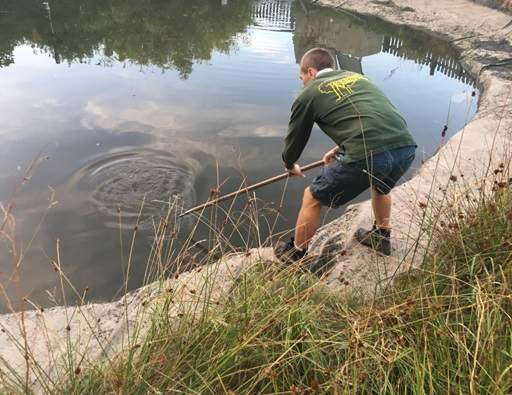
- Feed fish regularly with a varied diet, being careful not to overfeed. Any food left in the pond after 10 minutes should be removed to maintain the water quality.
- Aerate the pond by topping it up (ideally with rainwater) from a hose at a height of 1 metre (3 feet) above the surface of the water. If you have a water fountain that should do the job for you.

Jobs Elsewhere in the Garden
- If you spot any powdery mildew on your plants, remove the affected parts and spray with a fungicide to prevent it spreading any further.
- Look out for aphids on the underside of leaves, removing by hand and treating with an insecticide spray. These pesky bugs will suck the sap from your plants if left unchecked.
- Turn compost heaps every month to keep them well aerated. If it's been very dry, water them occasionally to make sure they keep decomposing. Place a sheet of cardboard or old carpet on top to retain moisture if your composter does not have a lid.
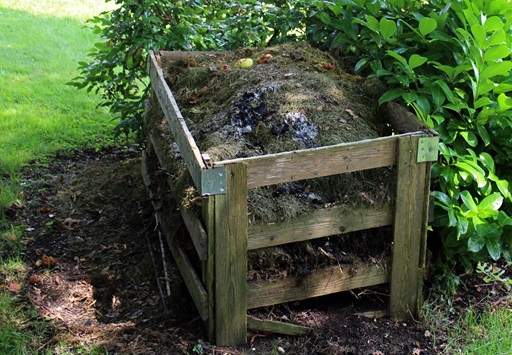
Helping Wildlife
- Dead head Buddleja bushes to keep them flowering into the autumn. Whilst the new flowers will be smaller they provide an important source of food for bees and other insects.
- Leave seed heads on some plants to provide extra food for birds and small mammals.
- Remove algae from bird baths to prevent it from stagnating the water and keep them well topped up to help the birds during the height of the summer.
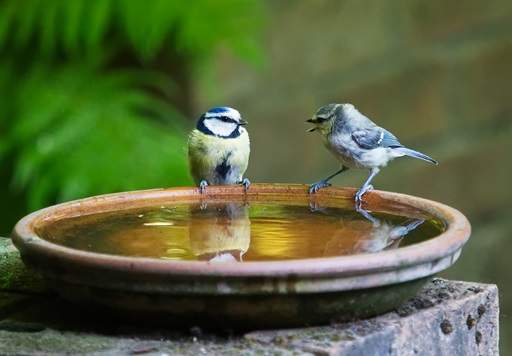
From your deckchair
- Look for gaps in your borders where spring bulbs can be planted over the next couple of months.
- Think about where you want to grow daffodils and narcissi, best in natural-looking random drifts over grass. Order and plant daffodils by the end of October at three times their own depth, adding bonemeal to the planting hole and grit if you have a heavy clay soil.
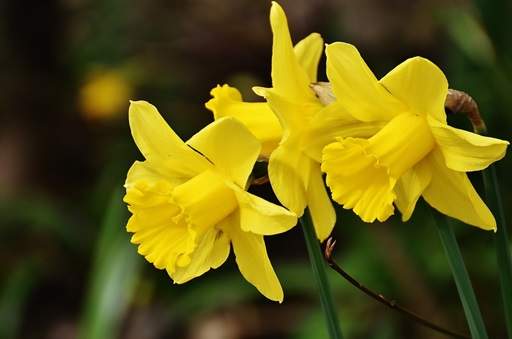
- Order any new trees, bushes and cane fruit you want to plant in the autumn.
- Consider which perennials you'd like to order for delivery in the autumn.
- Sketch the layout of your vegetable plot and flower borders, noting down the pros and cons of the layout to help you plan for next year.
- Think how you may want to re-arrange your garden over the winter, taking photos for reference.
- Share the best photographs and videos of your garden in full bloom on our Facebook page.
- Finally, take some time out to potter around your garden, take a seat or a deck chair and just enjoy spending some time being in it.
Share this page:

